Introduction: Multiple Ultrasonic Sensor Using Single Arduino
Abstract :
In this project, I am controlling 5 LEDs and 5 ultrasonic sensors using a single Arduino board. each sensor is pointed to a particular led and all 5 LEDs maintain their state for a particular period of time.
The purpose of this project is to get distance data from multiple sensors simultaneously and using this data to control LEDs.
Components Required:
Step 1: Wiring and Schematic
I am using an ultrasonic sensor in single-wire mode.
using only one wire for trigger and echo
Ultrasonic Sensor 1,2,3,4,5
US1-----Echo------Trigger = Signal 1 (Short Both echo and trigger of 1 ultrasonic sensor)
US2-----Echo-------Trigger = Signal 2
US3-----Echo-------Trigger = Signal 3
US4-----Echo-------Trigger = Signal 4
US5-----Echo-------Trigger= Signal 5
Arduino----------HC-SR04
Pin 8------------US1 = Signal 1 = Echo1+Trigger1
Pin 9------------US2 = Signal 2 = Echo2+Trigger2
Pin 10----------US3 = Signal 3 = Echo3+Trigger3
Pin 11----------US4 = Signal 4 = Echo4+Trigger4
Pin 12----------US5 = Signal 5 = Echo5+Trigger5
5v---------------US 1,2,3,4,5 (5V)
GND-----------US 1,2,3,4,5 (GND)
Arduino------------LEDs
pin3------------------LED1
pin4------------------LED2
pin5------------------LED3
pin6------------------LED4
pin7------------------LED5
GND----------------LED GND
Step 2: Code and Working
The main heart of this project is the new ping library.= Download Library from here
Code = Download code from here
This Code doesn't use any delays and is event-driven.
You can think of it as multitasking.
void loop() {
for (uint8_t i = 0; i < SONAR_NUM; i++) { // Loop through all the sensors.
if (millis() >= pingTimer[i]) { // Is it this sensor's time to ping?
pingTimer[i] += PING_INTERVAL * SONAR_NUM; // Set next time this sensor will be pinged.
if (i == 0 && currentSensor == SONAR_NUM - 1)
oneSensorCycle(); // Sensor ping cycle complete, do something with the results.
led (); //Turn ON the LEDs according to State.
if((millis() >= time_now + period) && (led1State == HIGH || led2State == HIGH || led3State == HIGH || led4State == HIGH || led5State == HIGH ) ){//15s delay using millis function and it only starts when any one LED is ON.
time_now = millis();
/*after 15s set, all LEDs state to LOW.*/
led1State = LOW;
led2State = LOW;
led3State = LOW;
led4State = LOW;
led5State = LOW;
}
sonar[currentSensor].timer_stop(); // Make sure previous timer is canceled before starting a new ping (insurance).
currentSensor = i; // Sensor being accessed.
cm[currentSensor] = 0; // Make distance zero in case there's no ping echo for this sensor.
sonar[currentSensor].ping_timer(echoCheck); // Do the ping (processing continues, interrupt will call echoCheck to look for echo).
}
}
}for (uint8_t i = 0; i < SONAR_NUM; i++) { // Loop through all the sensors.for() loop in void loop() polls each sensor array waiting for when it's that sensor's time to ping.
void echoCheck()
{ // If ping received, set the sensor distance to array.
if (sonar[currentSensor].check_timer())
cm[currentSensor] = sonar[currentSensor].ping_result / US_ROUNDTRIP_CM;
}
echoCheck() is where the background ping is polled every 24uS to see if ping was received, it sets the ping distance in CM in the cm array.
oneSensorCycle(); // Sensor ping cycle complete, do something with the results.
oneSensorCycle() uses the distance data collected from different sensors to turn ON-OFF the LEDs.
void oneSensorCycle() { // Sensor ping cycle complete, do something with the results.
/*Store sensor data in Array*/
for (uint8_t i = 0; i < SONAR_NUM; i++)
{
sensors[i] = cm[i];
}
/*LED Logic Start Using if Statemet*/
if (sensors[0] > 0 && sensors[0] <= dis)
{
led1State = HIGH;
}
if (sensors[1] > 0 && sensors[1] <= dis)
{
led2State = HIGH;
}
if (sensors[2] > 0 && sensors[2] <= dis)
{
led3State = HIGH;
}
if (sensors[3] > 0 && sensors[3] <= dis)
{
led4State = HIGH;
}
if (sensors[4] > 0 && sensors[4] <= dis)
{
led5State = HIGH;
}
if ((sensors[0] > 0 && sensors[0] <= dis) && (sensors[1] > 0 && sensors[1] <= dis))
{
led1State = HIGH;
led2State = HIGH;
}
if ((sensors[1] > 0 && sensors[1] <= dis) && (sensors[2] > 0 && sensors[2] <= dis))
{
led2State = HIGH;
led3State = HIGH;
}
if ((sensors[2] > 0 && sensors[2] <= dis) && (sensors[3] > 0 && sensors[3] <= dis))
{
led3State = HIGH;
led4State = HIGH;
}
if ((sensors[3] > 0 && sensors[3] <= dis) && (sensors[4] > 0 && sensors[4] <= dis))
{
led4State = HIGH;
led5State = HIGH;
}
if ((sensors[4] > 0 && sensors[4] <= dis) && (sensors[0] > 0 && sensors[0] <= dis))
{
led1State = HIGH;
led5State = HIGH;
}
}The Block diagram of this LEDs logic is shown above.
if((millis() >= time_now + period) && (led1State == HIGH || led2State == HIGH || led3State == HIGH || led4State == HIGH || led5State == HIGH ) ){//15s delay using millis function and it only starts when any one LED is ON.
time_now = millis();
/*after 15s set, all LEDs state to LOW.*/
led1State = LOW;
led2State = LOW;
led3State = LOW;
led4State = LOW;
led5State = LOW;
}Turn OFF the LEDs after 15 Seconds using millis() function.














